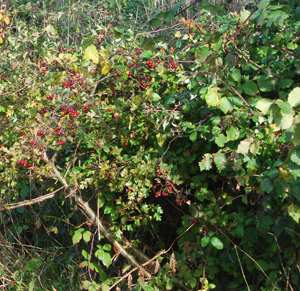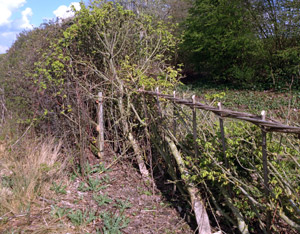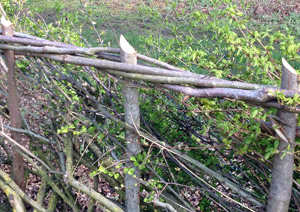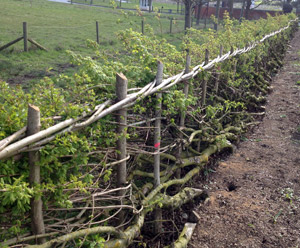British hedges ( in woodlands, gardens and farms)

We British like our hedges - perhaps it's part of the British reserve, keeping people at arms' length, or maybe it's because they are very functional for keeping stock in fields and marking boundaries. For wildlife, hedgerows have long been important avenues of local migration and hedges represent their own distinct habitat.
The attitude of the authorities towards hedges has undergone a roller coaster ride over the last 50 years. In the 1970s, the government were paying grants for the removal of hedges with the objective of encouraging the creation of larger fields to make agriculture more efficient - these were bad times for conservation - Oliver Rackham describes these as "the locust years". More recently grants have been available for planting hedges and their unauthorised removal in the countryside has become a criminal offence with the Hedgerow Regulations of 1997.
A recent book, "Hedge Britannia" by Hugh Barker is an unusual tour of hedges through the ages and in different parts of Britain. Barker also describes the huge customs hedge which the British planted in India in the 1840s to help collect the salt tax. This was 2,500 miles long although about 1,500 miles of it was "dead hedge", such as piles of dead thorn branches. Where traces of this Indian customs hedge can still be found they have now become mature trees; this is the more general result of hedge neglect. In many woodlands you can find rows of trees on a bank which would originally have been thriving hedges.
 The pre-eminent work on hedges is called "Hedges" by Dr Max Hooper and Dr E Pollard. This is based on many experiments and investigations into hedgerow management, and it includes "Hooper's Law" which states that hedges can be dated approximately by how many woody species are found in a 100 foot length. Multiplying this number by 100 gives you a very rough estimate as to the age of that hedge. This cannot be applied to the vast quantity of urban hedges, many of which are privet hedges at the front and back of Victorian and Edwardian houses. Such hedges were commonly planted with the building of houses right up until the second world war and the 1920s "Homes for Heroes" houses often have their boundaries marked with privet hedges and a huge length of such garden hedges are maintained today by British householders.
The pre-eminent work on hedges is called "Hedges" by Dr Max Hooper and Dr E Pollard. This is based on many experiments and investigations into hedgerow management, and it includes "Hooper's Law" which states that hedges can be dated approximately by how many woody species are found in a 100 foot length. Multiplying this number by 100 gives you a very rough estimate as to the age of that hedge. This cannot be applied to the vast quantity of urban hedges, many of which are privet hedges at the front and back of Victorian and Edwardian houses. Such hedges were commonly planted with the building of houses right up until the second world war and the 1920s "Homes for Heroes" houses often have their boundaries marked with privet hedges and a huge length of such garden hedges are maintained today by British householders.
Hedgelaying has become a popular countryside activity and is indeed very skillfull. The pictures below illustrate how good hedgelaying can be rather like a work of art and make a hedge solid and impenetrable by livestock. Hedgelayers sometimes compete and typically are given a 10 metre stretch to do but the judging sometimes includes a review of how the hedge has fared one year later - so instant wins in these hedgelaying competitions are not likely!
 Hedges are often kept from growing too high by flailing with a tractor and cutting attachment: this is usually done after the birds have nested but can leave the hedge looking injured. There is an argument that this flailing damages the hedge because it stresses the plants by repeatedly cutting in the same place - stems become twisted and gnarled with the hedge becoming unhealthy, in contrast to more traditional hedge management methods which will cut the hedge carefully at different levels. We have made a short film on hedge laying: http://www.youtube.com/watch?v=Andv7a0NPEc
Hedges are often kept from growing too high by flailing with a tractor and cutting attachment: this is usually done after the birds have nested but can leave the hedge looking injured. There is an argument that this flailing damages the hedge because it stresses the plants by repeatedly cutting in the same place - stems become twisted and gnarled with the hedge becoming unhealthy, in contrast to more traditional hedge management methods which will cut the hedge carefully at different levels. We have made a short film on hedge laying: http://www.youtube.com/watch?v=Andv7a0NPEc
With patience you can create a new hedge as a woodland boundary. What you plant with will depend on both the soil conditions and purposes of the hedge. Hawthorn makes a hedge which is hard to penetrate, whilst yew or beech can make a very ornate hedge. Neighbours and others will probably be happier if you avoid the hated leylandii and stick to native species ideally sourcing your stock as locally as possible. The process is not instant: as Hugh Barker of "Hedge Britannia" says: "creating a proper hedge ...takes time and commitment. In a lazier, less patient world ...we are in danger of losing our appreciation of slower approaches."
Comments are closed for this post.
Discussion
Dear Sir I live in south London and have a mixed hedge in my garden, that has got “out of hand”
The hedge is a mixture of Blackthorn , Hawthorn etc. & about thirty foot long.
I would like to layer it, for the wildlife? But I am worried about buying a “Billhook” and then carrying it home on public transport, and what else I required for the job and the correct time of year to do the job.
Thanking you in advance
Kevin Christie
[…] as the classic Hedges, by Pollard, Moore and Hooper) at woodlands.co.uk – you can link to it here. Like this:LikeBe the first to like […]
A hedge publication by a “Dr. E Pollard”? Fantastic!
Come and learn the basic principals with my Group at our 4 day course in February, you will actually get to lay your own 20 metre section, find out more at http://www.coppicewoodcollege.co.uk





Very interesting article, I’m thinking of planting a Hawthorn hedge.
Ray Ruddick
22 October, 2022